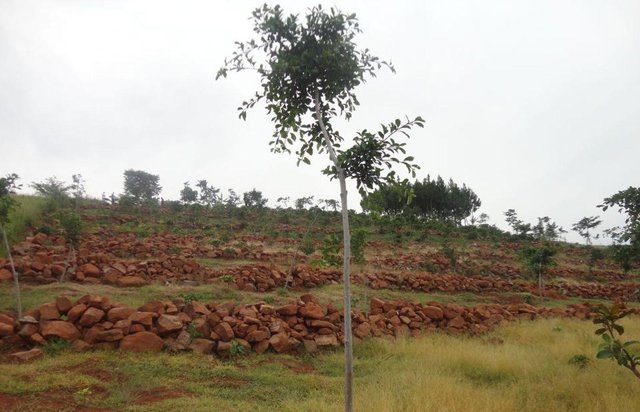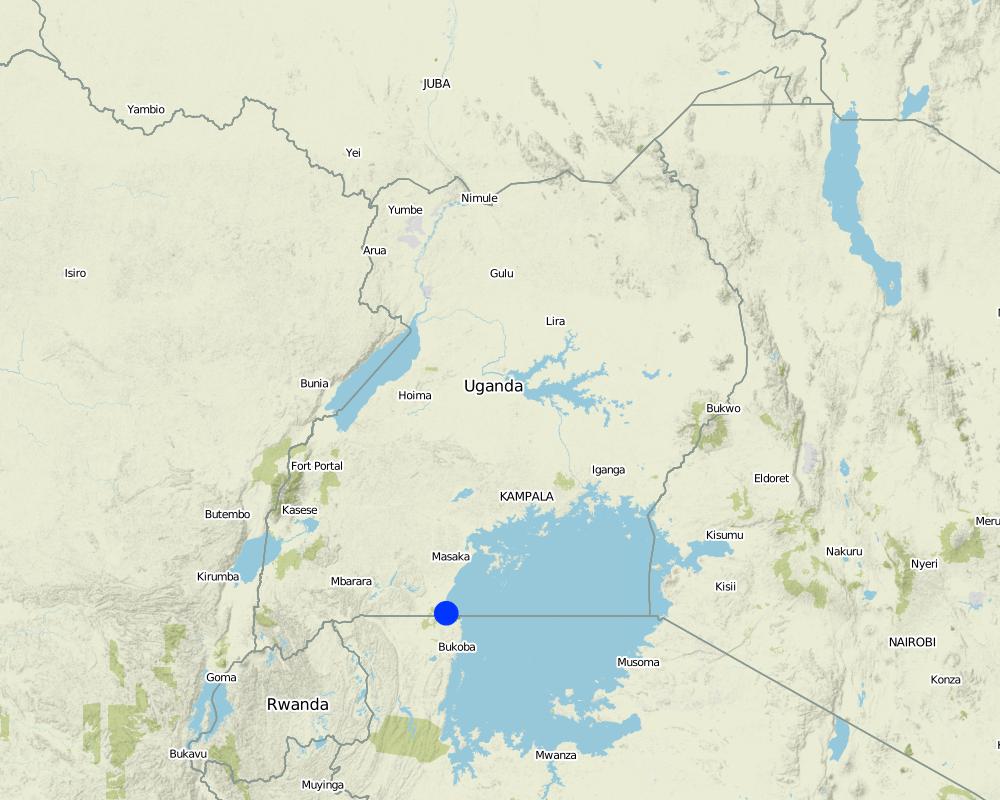FFS/SLM Community Initiative [អ៊ូហ្គង់ដា]
- ការបង្កើត៖
- បច្ចុប្បន្នភាព
- អ្នកចងក្រង៖ Wilson Bamwerinde
- អ្នកកែសម្រួល៖ –
- អ្នកត្រួតពិនិត្យ Fabian Ottiger
Farmer Field School
approaches_2487 - អ៊ូហ្គង់ដា
ពិនិត្យមើលគ្រប់ផ្នែក
ពង្រីកមើលទាំងអស់ បង្រួមទាំងអស់1. ព័ត៌មានទូទៅ
1.2 ព័ត៌មានលម្អិតពីបុគ្គលសំខាន់ៗ និងស្ថាប័នដែលចូលរួមក្នុងការវាយតម្លៃ និងចងក្រងឯកសារនៃវិធីសាស្ត្រផ្សព្វផ្សាយ
1.3 លក្ខខណ្ឌទាក់ទងទៅនឹងការប្រើប្រាស់ទិន្នន័យដែលបានចងក្រងតាមរយៈវ៉ូខេត
តើពេលណាដែលទិន្នន័យបានចងក្រង (នៅទីវាល)?
13/12/2013
អ្នកចងក្រង និង(បុគ្គលសំខាន់ៗ)យល់ព្រមទទួលយកនូវលក្ខខណ្ឌនានាទាក់ទងទៅនឹងការប្រើប្រាស់ទិន្នន័យដែលបានចងក្រងតាមរយៈ វ៉ូខេត:
បាទ/ចា៎
1.4 ការយោងមួយ (ច្រើន) ទៅលើ (កម្រង) បញ្ជីសំណួរនៃបច្ចេកទេស SLM

Stone lines [អ៊ូហ្គង់ដា]
Stone lines are built along a contour to control soil erosion on a degraded steep slope.
- អ្នកចងក្រង៖ Wilson Bamwerinde
2. ការពណ៌នាអំពីវិធីសាស្ត្រផ្សព្វផ្សាយ SLM
2.1 ពណ៌នាសង្ខេបខ្លីពីវិធីសាស្ត្រផ្សព្វផ្សាយ
Farmers are organized to promote adoption of sustainable land management best practices within the community
2.2 ពណ៌នាលម្អិតពិវិធីសាស្ត្រផ្សព្វផ្សាយ
ពណ៌នាលម្អិតពិវិធីសាស្ត្រផ្សព្វផ្សាយ:
Aims / objectives: To train farmers in land based technologies that improve productivity, land management and are resilient to climate changes
Methods: Planning meetings, agro-ecosystem analysis (AESA), farmer-to-farmer visits, monitoring and evaluation
Stages of implementation: Farmer Field School (FFS) formation to bring together 30 farmers from a catchment area; training in group dynamics; training in best practices to address land degradation problems; AESA; and action planning
Role of stakeholders: District facilitators: Facilitation of FFS formation, training of trainers for AESA, drawing village land use plans, prioritizing enterprises/challenges, making technical recommendations; Local leaders: Passing and implementing bye-laws.
2.5 ប្រទេស/តំបន់/ទីតាំងកន្លែង ដែលវិធីសាស្ត្រផ្សព្វផ្សាយត្រូវបានអនុវត្តន៍
ប្រទេស:
អ៊ូហ្គង់ដា
តំបន់/រដ្ឋ/ខេត្ត:
Uganda
បញ្ជាក់បន្ថែមពីលក្ខណៈនៃទីតាំង:
Kijonjo, Katongero, Rakai District
Map
×2.6 កាលបរិច្ឆេទនៃការចាប់ផ្តើម និងបញ្ចប់នៃវិធីសាស្រ្តផ្សព្វផ្សាយនេះ
សូមបញ្ជាក់ឆ្នាំដែលបានបង្កើតឡើង:
2011
ឆ្នាំបញ្ចប់ (ប្រសិនបើវិធីសាស្ត្រផ្សព្វផ្សាយត្រូវបានឈប់ប្រើប្រាស់):
2015
2.7 ប្រភេទនៃវិធីសាស្ត្រផ្សព្វផ្សាយ
- ផ្អែកលើគម្រោង/កម្មវិធី
2.8 គោលបំណង/ទិសដៅសំខាន់នៃវិធីសាស្ត្រផ្សព្វផ្សាយ
The Approach focused on SLM only (Sustainable Land Management Farmer Cooperative)
To share knowledge, skills and information on establishment of local best practices to improve productivity and biodiversity and reduce soil erosion
The SLM Approach addressed the following problems: Low soil nutrient levels, vegetation loss and soil erosion on steep slopes
2.9 លក្ខខណ្ឌអនុញ្ញាត ឬរារាំងការអនុវត្តន៍បច្ចេកទេសដែលស្ថិតនៅក្រោមវិធីសាស្រ្តផ្សព្វផ្សាយ
ភាពអាចរកបាននៃធនធានហិរញ្ញវត្ថុ និងសេវាកម្ម
- រារាំង
Inadequate resources because farming is mainly subsistent
Treatment through the SLM Approach: Farmers formed cooperatives to pool resources
ចំណេះដឹងស្តីពី SLM និងការទទួលបានការគាំទ្រផ្នែកបច្ចេកទេស
- រារាំង
Little available information on addressing land management issues
Treatment through the SLM Approach: Trained facilitators were sourced to provide appropriate knowledge to address relevant constraints
ទំហំការងារ ភាពអាចរកបាននៃកម្លាំងពលកម្ម
- រារាំង
Increased workload required in the implementation caused expenses on hired labor to rise.
Treatment through the SLM Approach: Sharing workload through working together to dig up stones and carry them on steep slopes, lay them along contours and plant Ficus natalensis to stabilize the soil
3. ការចូលរួម និងតួនាទីរបស់ភាគីពាក់ព័ន្ធ
3.1 អ្នកពាក់ព័ន្ធដែលបានចូលរួមក្នុងវិធីសាស្ត្រផ្សព្វផ្សាយ និងតួនាទីរបស់ពួកគេ
- អ្នកប្រើប្រាស់ដីក្នុងតំបន់/សហគមន៍
Women constitute the majority of farmers in attendance because most agricultural production in the district is carried out by women, except in cattle-keeping areas where men are the majority
- អ្នកឯកទេសគ្រប់គ្រងដីប្រកបដោយចីរភាព/ទីប្រឹក្សាបច្ចេកទេសកសិកម្ម
- រដ្ឋាភិបាលថ្នាក់មូលដ្ឋាន
District facilitators were provided by the district local government
- រដ្ឋាភិបាលថ្នាក់ជាតិ (អ្នករៀបចំផែនការ អ្នកសម្រេចចិត្ត)
Collaboration with the line Central Government Ministries through the Project Steering Committee at Permanent Secretary level
- អង្គការអន្តរជាតិ
Kagera TAMP (FAO-GEF) provided funding for specialist facilitators
ប្រសិនមានភាគីពាក់ព័ន្ធច្រើនចូលរួមសូមចង្អុលបង្ហាញភ្នាក់ងារដែលនាំមុខគេ:
Kagera TAMP international specialists with the help of national FFS specialists
3.2 ការចូលរួមរបស់អ្នកប្រើប្រាស់ដីក្នុងតំបន់/ សហគមន៍ក្នុងតំបន់ក្នុងដំណាក់កាលផ្សេងគ្នានៃវិធីសាស្រ្តផ្សព្វផ្សាយ
| ការចូលរួមរបស់អ្នកប្រើប្រាស់ដីក្នុងតំបន់/សហគមន៍ក្នុងតំបន់ | សូមបញ្ជាក់នរណាត្រូវបានចូលរួម ព្រមទាំងពណ៌នាសកម្មភាពទាំងនោះ | |
|---|---|---|
| ការចាប់ផ្តើម/ការលើកទឹកចិត្ត | អន្តរកម្ម | FFS specialist facilitator with prospective FFS members to get farmers organized in FFS (30 members each) |
| ការរៀបចំផែនការ | អន្តរកម្ម | Farmers in their farmer field schools sketched watershed maps and developed action plans with the help of district facilitators |
| ការអនុវត្តន៍ | អន្តរកម្ម | Facilitators helped FFS members in the dynamics that sustained and strengthened the Approach |
| ការត្រួតពិនិត្យ និងវាយតម្លៃ | អសកម្ម | A few members were co-opted to the monitoring team which comprised local government facilitators, Kagera TAMP Project specialists and the central government Project Steering Committee |
| Research | អន្តរកម្ម | FFS members carried out Agro-ecosystem Analysis (AESA) with training and field support from specialists |
3.4 ការសម្រេចចិត្តលើការជ្រើសរើសបច្ចេកទេស SLM
សូមបញ្ជាក់តើអ្នកណាជាអ្នកបានសម្រេចចិត្តក្នុងការជ្រើសរើសបច្ចេកទេសដើម្បីយកមកអនុវត្តន៍:
- អ្នកប្រើប្រាស់ដី ដោយមានការគាំទ្រពីអ្នកជំនាញឯកទេស SLM
ចូរពន្យល់:
The FFS concept and methodology were introduced to the farmers by SLM specialists. The decisions on technology choice were the result of discussions bf the farmers with support from the specialists.
Decisions on the method of implementing the SLM Technology were made by mainly by land users supported by SLM specialists. Farmers in the FFS decided how to overcome constraints posed by their hilly terrain and high cost of labor
4. ជំនួយបច្ចេកទេស ការកសាងសមត្ថភាព និងការគ្រប់គ្រងចំណេះដឹង
4.1 ការកសាងសមត្ថភាព/ បណ្តុះបណ្តាល
តើវគ្គបណ្តុះបណ្តាលបានផ្តល់ឱ្យអ្នកប្រើប្រាស់ដី/អ្នកពាក់ព័ន្ធផ្សេងៗទៀតដែរឬទេ?
បាទ/ចា៎
សូមបញ្ជាក់តើអ្នកណាត្រូវបានបណ្តុះបណ្តាល:
- អ្នកប្រើប្រាស់ដី
- បុគ្គលិកចុះទីវាល/អ្នកផ្តល់ប្រឹក្សាយោបល់
- Politicians/Policy Makers
ទម្រង់នៃការបណ្តុះបណ្តាល:
- អនុវត្តន៍ជាមួយការងារ
- ពីកសិករទីកសិករ
- ទីតាំងបង្ហាញ
- ការប្រជុំជាសាធារណៈ
ប្រធានបទបណ្តុះបណ្តាល:
Extension Training: use of demonstration plots and AESA to experiment and discover the appropriate methodology for implementation of SLM technologies. A formal session involves a facilitator and farmers. The facilitator guides the farmers on how to investigate a problem using marker-drawn sketches on flip chart. Observations, conclusions and recommendations are reached in a participatory manner.
Extension: FFS members adopt a resolution to carry out the recommended procedures/activities; community members are free to interact with FFS members on field days and copy recommendations. Farmer-to-farmer visits are encouraged and promoted to extend information.
Research: FFS members research together on a given problem/challenge such as soil fertility and arrive at recommendations together. They are guided by facilitators from government or government research institutions with collaborative support from Kagera TAMP/FAO project.
Importance of land use rights: Ownership of land affects land management practices. The attitude towards the recommendation by farmers is usually determined by the FFS members. In Kagera TAMP districts land ownership is customary but the right to use land is governed by national laws.
Incentives:
Labor: Farmer Field School members provide the labor to implement technologies. Hired labor may also be used.
Inputs: Farmers provide the basic tools such as hoes, pick axe etc. Seedlings and seeds may be provided by the project.
Credit: Small amounts may be acquired from the FFS cooperative savings.
4.3 ការពង្រឹងសមត្ថភាពស្ថាប័ន (ការអភិរឌ្ឍន៍អង្គភាព)
តើស្ថាប័នទាំងអស់ត្រូវបានបង្កើតឡើង ឬពង្រឹងសមត្ថភាពតាមរយៈវិធីសាស្ត្រផ្សព្វផ្សាយដែរ ឬទេ?
- បាទ/ច៎ា បានខ្លាំង
សូមបញ្ជាក់ថាតើស្ថាប័នត្រូវបានពង្រឹង ឬបង្កើតឡើងនៅត្រឹមកម្រិតណា(ច្រើន)?
- ថ្នាក់មូលដ្ឋាន
សូមបញ្ជាក់ប្រភេទនៃការគាំទ្រ:
- ការកសាងសមត្ថភាព/ បណ្តុះបណ្តាល
- សម្ភារៈ
សូមផ្តល់ព័ត៌មានបន្ថែមទៀតឱ្យបានលម្អិត:
Training workshops in Sustainable Land Management (SLM) and Land Degradation Assessment (LADA) both national and international, seminars, and procurement and training in the use of computers, digital cameras and GPS units
4.4 ការត្រួតពិនិត្យ និងវាយតម្លៃ
តើការត្រួតពិនិត្យ និងវាយតម្លៃគឺជាផ្នែកមួយនៃវិធីសាស្ត្រដែរឬទេ?
បាទ/ចា៎
មតិយោបល់:
bio-physical aspects were regular monitored by project staff, government, land users through observations; indicators: Measurement of crop yield, soil nutrients, biodiversity
bio-physical aspects were regular monitored by project staff, government, land users through measurements; indicators: Measurement of crop yield, soil nutrients, biodiversity
economic / production aspects were regular monitored by government, land users through observations; indicators: Measurement of crop yield, vigor
economic / production aspects were regular monitored by government through measurements; indicators: Measurement of crop yield, vigor
area treated aspects were regular monitored by project staff, government through observations; indicators: Measure by attendance, morale
area treated aspects were regular monitored by project staff, government through measurements; indicators: Measure by attendance, morale
no. of land users involved aspects were regular monitored by project staff through observations; indicators: None
no. of land users involved aspects were regular monitored by project staff through measurements; indicators: None
management of Approach aspects were None monitored by project staff through observations; indicators: None
management of Approach aspects were None monitored by project staff through measurements; indicators: None
There were few changes in the Approach as a result of monitoring and evaluation: FFS constantly refines and improves on what and how to achieve objectives, to discover and archive best practices in the most effective forms possible
There were few changes in the Technology as a result of monitoring and evaluation: Height of stone lines, width between lines
4.5 ការស្រាវជ្រាវ
តើការស្រាវជ្រាវ គឺជាផ្នែកមួយនៃវិធីសាស្រ្តដែរឬទេ?
បាទ/ចា៎
បញ្ជាក់ប្រធានបទ:
- បរិស្ថានវិទ្យា
សូមផ្តល់ព័ត៌មានបន្ថែមទៀតឱ្យបានលម្អិត និងចង្អុលបង្ហាញនរណាដែលបានធ្វើការស្រាវជ្រាវ:
Agro-ecosystem Analysis (AESA) by FFS members
Research was carried out on-farm
5. ថវិកា និងសម្ភារៈឧបត្ថម្ភពីខាងក្រៅ
5.1 ថវិកាប្រចាំឆ្នាំសម្រាប់ផ្សព្វផ្សាយ SLM
ប្រសិនបើចំនួនពិតប្រាកដនៃថវិកាប្រចាំឆ្នាំមិនត្រូវបានដឹងច្បាស់ សូមប្រាប់ពីចន្លោះនៃថវិកានោះ:
- < 2,000
មតិយោបល់ (ឧ. ប្រភពសំខាន់នៃមូលនិធិ/ម្ចាស់ជំនួយចំបង):
Approach costs were met by the following donors: international (Kagera TAMP): 18.95%; local government (district, county, municipality, village etc) (District and Sub-county facilitator time): 11.14%; local community / land user(s) (Land users as FFS members): 69.91%
5.2 ការគាំទ្រផ្នែកហិរញ្ញវត្ថុ / សម្ភារៈដែលបានផ្តល់ទៅឱ្យអ្នកប្រើប្រាស់ដី
តើអ្នកប្រើប្រាស់ដីបានទទួលការគាំទ្រផ្នែកហិរញ្ញវត្ថ/សម្ភារៈសម្រាប់ការអនុវត្តន៍បច្ចេកទេសដែរឬទេ:
ទេ
5.3 សូមបញ្ជាក់ពីធាតុចូលត្រូវបានផ្តល់បដិភាគ (រួមទាំងកម្លាំងពលកម្ម)
ប្រសិនបើកម្លាំងពលកម្មធ្វើដោយអ្នកប្រើប្រាស់ដី តើវាជាធាតុចូលដ៏សំខាន់មួយដែរ ឬទេ:
- ដោយស្ម័គ្រចិត្ត
មតិយោបល់:
FFS members were facilitated with information and they carried out the approach without any financial or material support
5.4 ឥណទាន
តើឥណទានដែលបានផ្តល់នៅក្រោមវិធីសាស្ត្រផ្សព្វផ្សាយសម្រាប់សកម្មភាព SLM នេះយ៉ាងដូចម្តេច?
ទេ
6. ការវិភាគរកផលប៉ះពាល់ និងសេចក្តីសន្និដ្ឋាន
6.1 ផលប៉ះពាល់នៃវិធីសាស្ត្រផ្សព្វផ្សាយ
តើវិធីសាស្ត្រផ្សព្វផ្សាយជួយអ្នកប្រើប្រាស់ដីដើម្បីអនុវត្តន៍ និងថែទាំបច្ចេកទេស SLM?
- ទេ
- បាទ/ច៎ា បន្តិចបន្តួច
- បាទ/ច៎ា ជាមធ្យម
- បាទ/ច៎ា បានខ្លាំង
Formerly disused land was made productive
Did other land users / projects adopt the Approach?
- ទេ
- បាទ/ច៎ា បន្តិចបន្តួច
- បាទ/ច៎ា ជាមធ្យម
- បាទ/ច៎ា បានខ្លាំង
Did the Approach lead to improved livelihoods / human well-being?
- ទេ
- បាទ/ច៎ា បន្តិចបន្តួច
- បាទ/ច៎ា ជាមធ្យម
- បាទ/ច៎ា បានខ្លាំង
Crop diversification, food security
Did the Approach help to alleviate poverty?
- ទេ
- បាទ/ច៎ា បន្តិចបន្តួច
- បាទ/ច៎ា ជាមធ្យម
- បាទ/ច៎ា បានខ្លាំង
FFS savings and credit cooperative helping members to access small unsecured agro-input financing
6.2 ការលើកទឹកចិត្តចម្បងៗរបស់អ្នកប្រើប្រាស់ដីសម្រាប់ការអនុវត្តបច្ចេកទេស SLM
- បង្កើនផលិតកម្ម
- បង្កើនប្រាក់ចំណេញ (សមត្ថភាព) បង្កើនអត្រាចំណេញ
- ពង្រឹងស្មារតីផ្នែកបរិស្ថាន
6.3 សកម្មភាពផ្សព្វផ្សាយដែលប្រកបដោយចីរភាព
តើអ្នកប្រើប្រាស់ដីអាចធ្វើឱ្យមានចីរភាពនូវអ្វីដែលត្រូវបានអនុវត្តន៍តាមរយៈវិធីសាស្ត្រផ្សព្វផ្សាយដែរឬទេ(ដោយពុំមានការគាំទ្រពីអ្នកខាងក្រៅ)?
- បាទ/ចា៎
ការតភ្ជាប់ និងម៉ូឌុល
ពង្រីកមើលទាំងអស់ បង្រួមទាំងអស់ការតភ្ជាប់

Stone lines [អ៊ូហ្គង់ដា]
Stone lines are built along a contour to control soil erosion on a degraded steep slope.
- អ្នកចងក្រង៖ Wilson Bamwerinde
ម៉ូឌុល
គ្មានម៉ូឌុល


